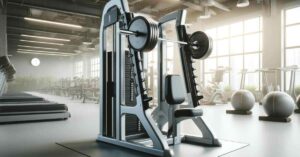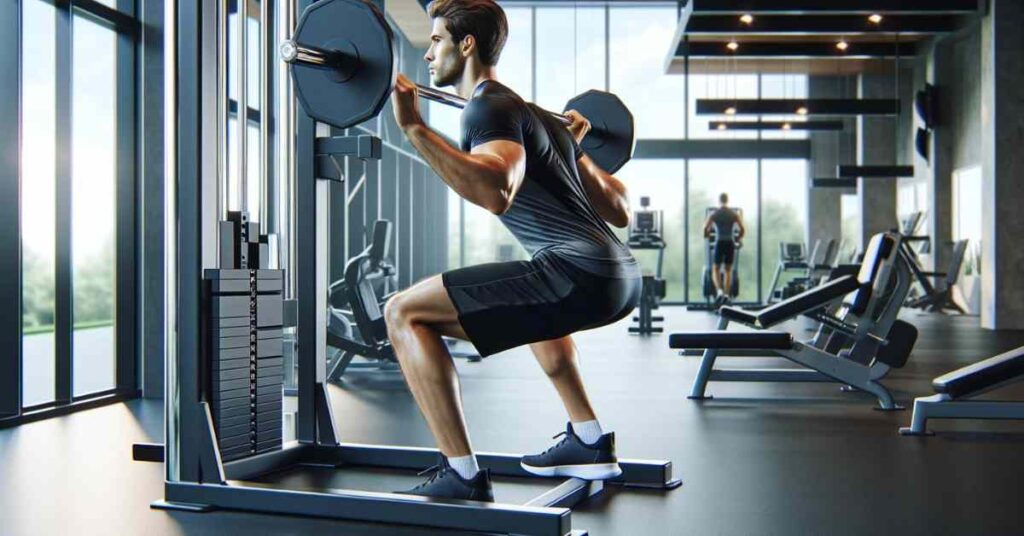Introduction to Hack Squat Machines
The hack squat machine is a staple in many gyms and a favorite among fitness enthusiasts looking to enhance their lower body strength. Unlike traditional squats, the hack squat machine provides a guided motion, which helps in maintaining the correct posture and targeting specific muscle groups more effectively. This introduction will explore the machine’s relevance and advantages in a fitness regimen.
Understanding the Hack Squat Machine
What is a Hack Squat Machine?
A hack squat machine is designed to allow the user to perform squat movements while positioned in a sled that glides on a fixed track. The user’s back is supported by a pad, reducing the strain on the spine and focusing the effort on the legs. This section will detail the unique aspects of the machine’s design and how they contribute to its effectiveness.
The Mechanics of Hack Squat Machines
Understanding the mechanics behind the hack squat machine is essential for both safety and effectiveness. The machine typically includes adjustable weights, which can be customized according to the user’s fitness level and goals. We’ll discuss how these components work together to provide a controlled environment that minimizes the risk of injury and maximizes the potential for muscle growth and strength.
Benefits of Using a Hack Squat Machine
Enhanced Safety
One of the standout features of the hack squat machine is its safety. Designed to minimize the risk of injury, the machine allows users to perform squats without the burden of balancing a barbell, which can lead to lower back strain in traditional squats. The back support and fixed path of movement help ensure that users maintain proper form throughout their exercise, protecting the spine and knees from common injuries associated with squats.
Targeted Muscle Groups
The hack squat machine is highly effective in targeting the quadriceps, hamstrings, glutes, and calves. By adjusting your foot placement on the plate, you can further isolate these muscles, making the hack squat a versatile addition to any leg workout. This section explains how different foot positions affect muscle engagement, offering tips on how to maximize muscle growth and strength development.
Increased Strength and Muscle Mass
Regular use of the hack squat machine can lead to significant increases in lower body strength and muscle mass. The ability to load the machine with substantial weight, much more comfortably than with traditional squats, means that users can progressively overload their muscles, leading to better gains. Here, we’ll explore how increasing resistance over time can help achieve fitness goals more effectively.
How to Use a Hack Squat Machine Correctly
Preparing for the Exercise
Before beginning a hack squat session, it’s important to adjust the machine to fit your body dimensions. This includes setting the shoulder pads and safety stops at appropriate heights to ensure comfort and avoid injury. We’ll discuss the essential pre-use checks and adjustments needed to ensure optimal performance and safety.
Step-by-Step Guide
- Start by positioning your back against the pad with your shoulders under the shoulder pads.
- Place your feet shoulder-width apart on the footplate, keeping your toes pointed slightly outward.
- Unlatch the safety handles and slowly lower yourself into a squat position by bending your knees, keeping your chest up and back straight.
- Press through your heels to lift the weight, extending your legs until you return to the starting position.
- Perform the desired number of repetitions, then safely latch the safety handles before exiting the machine.
This guide provides clear instructions on the correct form and motion to ensure effective workouts and reduce the risk of injuries.
Common Mistakes to Avoid
Many users make common mistakes that can reduce the effectiveness of their workouts or increase the risk of injury. We’ll highlight these pitfalls, such as descending too quickly, placing the feet too high or too low on the platform, and failing to maintain proper back alignment, and provide tips on how to avoid them.

Comparative Analysis of Hack Squat vs. Traditional Squats
Similarities and Differences
Both hack squats and traditional squats aim to strengthen the lower body, but they do so in different ways. Traditional squats involve a free weight (typically a barbell) and require the user to maintain balance and stability throughout the movement. This can engage more stabilizing muscles and contribute to core strength. In contrast, hack squats are performed on a machine that guides the movement, allowing the user to focus more intensely on the legs without worrying about balancing the weight.
Pros and Cons of Each Method
Pros of Hack Squats:
- Reduced risk of lower back and knee injuries due to supported posture.
- Ability to isolate leg muscles more effectively.
- Suitable for those with balance issues or beginners who are new to squatting.
Cons of Hack Squats:
- Less engagement of stabilizing muscles compared to free-weight squats.
- Potentially less functional strength development due to the guided motion.
Pros of Traditional Squats:
- Engages a wider range of muscles, including core and stabilizers.
- Improves balance, coordination, and overall functional fitness.
- Versatile with different types of equipment and techniques.
Cons of Traditional Squats:
- Higher risk of injury if performed with poor form, especially under heavy loads.
- May be intimidating for beginners or those with pre-existing injuries.
This analysis helps users decide which type of squat might best meet their fitness goals based on their current level and health considerations.
Choosing the Right Hack Squat Machine
Features to Look For
When selecting a hack squat machine for either a home gym or a commercial setting, certain features stand out as must-haves:
- Adjustability: Look for machines that offer easy adjustments for different body sizes and comfort levels.
- Durability: High-quality materials and solid construction ensure longevity and safety.
- Smooth Motion: Machines should offer a smooth gliding mechanism to reduce jerky movements and ensure a steady exercise.
- Weight Capacity: Ensure the machine can handle the amount of weight you plan to use for your workouts.
Recommendations for Home Gyms vs. Commercial Gyms
For home gyms, space efficiency and cost might be more critical, so a compact model that still offers stability and adjustability would be ideal. For commercial gyms, where the machine will see heavier use, opting for a robust model designed for durability and heavy loads would be more appropriate.
User Testimonials and Case Studies
Hearing from those who have incorporated hack squats into their routines can provide real-world insights into the benefits and practical use of these machines:
- Success Stories: Highlighting users who have seen significant improvements in muscle strength and size.
- Expert Opinions: Fitness trainers and physiotherapists can offer professional insights into the proper use and benefits of hack squats.
Maintaining Your Hack Squat Machine
Routine maintenance is essential to ensure your hack squat machine remains safe and effective over time. Here’s what you need to know to keep your machine in top condition:
- Routine Maintenance Tips:
- Lubrication: Regularly lubricate moving parts to ensure smooth operation and prevent wear and tear.
- Inspections: Periodically check all bolts and connections for tightness and stability, as these can loosen with regular use.
- Cleaning: Keep the machine clean from dust and sweat, which can corrode metal parts and degrade pads and other materials.
- Troubleshooting Common Issues:
- Unusual Noises: If you hear squeaking or grinding, it may indicate a need for lubrication or that a part is worn and needs replacement.
- Sticking or Jerky Movements: This often suggests that the guide rails or bearings need cleaning or lubricating.
By following these maintenance practices, you can extend the life of your hack squat machine and ensure it provides a safe, effective workout experience.
Incorporating Hack Squats into Your Workout Routine
Creating a balanced workout plan that includes hack squats can maximize your fitness results and prevent overtraining. Here’s how to incorporate hack squats effectively:
- Creating a Balanced Workout Plan:
- Frequency: Depending on your overall fitness goals, including hack squats 1-2 times per week can be sufficient.
- Volume and Intensity: Adjust the volume and intensity based on your fitness level and other leg exercises in your routine.
- Tips for Beginners to Advanced Levels:
- Beginners: Start with low weights to master the technique before adding resistance.
- Intermediate Users: Begin incorporating variations by adjusting foot placement to target muscles differently.
- Advanced Users: Incorporate drop sets or paused reps to increase intensity and stimulate muscle growth.
Potential Risks and How to Mitigate Them
While hack squats are generally safe when performed correctly, there are potential risks to be aware of:
- Common Injuries and How to Prevent Them:
- Knee Strain: Ensure proper form and don’t descend too low to prevent undue stress on the knees.
- Lower Back Stress: Keeping your back firmly against the pad throughout the motion can help minimize stress on the spine.
- When to Avoid Hack Squats:
- Individuals with pre-existing knee or back injuries may need to avoid hack squats or consult a physical therapist to adapt the exercise to their needs.
Future of Hack Squat Machines
As technology advances, we can expect to see innovations in hack squat machines, including more ergonomic designs and integrated technology for tracking progress and adjusting resistance dynamically.
Conclusion
Hack squats offer a highly effective way to build and strengthen the lower body safely. By understanding the machine, maintaining it properly, and using it as part of a balanced workout regimen, you can maximize its benefits and achieve your fitness goals.
FAQs
-
What are the main benefits of using a hack squat machine?
- Answer: The main benefits of using a hack squat machine include enhanced safety due to its guided motion, which helps prevent improper form and reduces the risk of injury. It specifically targets and effectively isolates the lower body muscles, such as the quadriceps, hamstrings, and glutes. Additionally, the machine allows for heavy lifting without the balance challenges posed by traditional squats, making it easier to focus on muscle strength and growth.
-
How does the hack squat machine differ from regular squats?
- Answer: The key difference between hack squat machines and regular squats lies in the motion and muscle focus. Hack squat machines provide a fixed path of motion, which helps maintain proper posture and reduces stress on the spine and knees. This allows for more targeted muscle training. In contrast, regular squats require more comprehensive body engagement, including core and stabilizing muscles, to maintain balance and form with free weights.
-
What should I look for when buying a hack squat machine?
- Answer: When purchasing a hack squat machine, consider the adjustability of the machine to accommodate different body sizes and exercise preferences. Look for durable construction and high-quality materials to ensure longevity and safety. Also, check for a smooth movement mechanism and adequate weight capacity to match your training requirements. Finally, consider the machine’s footprint, especially if you’re limited by space in a home gym.
-
Can hack squats replace traditional squats in my routine?
- Answer: Hack squats can complement or occasionally replace traditional squats, especially for individuals looking to reduce the strain on their back and knees or to focus intensively on their leg muscles. However, since traditional squats engage more stabilizing muscles and are more functional, it’s beneficial to include both types in a well-rounded fitness program, unless specific health considerations dictate otherwise.
-
Are there any age or health restrictions for using a hack squat machine?
- Answer: Generally, the hack squat machine is suitable for most ages and fitness levels, but individuals with existing knee, hip, or back issues should consult with a healthcare provider before incorporating hack squats into their routine. Older adults or those new to fitness might need to start with lighter weights and focus on proper form to avoid injuries.

